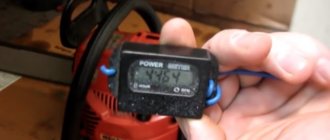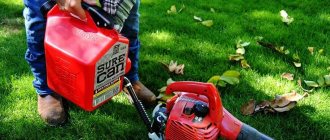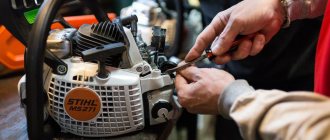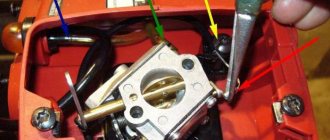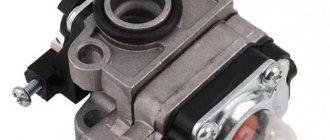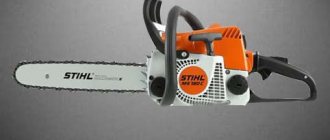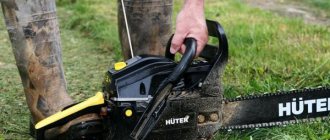A chainsaw is a highly efficient tool that is designed for working with wood. However, the high-speed motor of this tool can be used to perform a number of other tasks, which is achieved through special attachments. Sometimes a malfunction occurs such that the chainsaw stalls when you press the gas, which can be triggered by certain factors. To avoid having to completely disassemble the tool, we will consider all possible causes of this problem with a detailed description of how to eliminate them.
Where to look for the reason or where to start checking
All chainsaws have the same design and work on the same principle. The structure of a chainsaw can be found in this material. It doesn’t matter much what brand the instrument is - Shtil, Husqvarna, ECHO, Champion, Partner, Sturm and others. A malfunction that manifests itself in the form of a chainsaw stalling when you press the gas can occur equally on both expensive and high-quality tools and on budget Chinese devices. If a problem arises, it needs to be solved.
A chainsaw is a system of mechanisms consisting of parts. Any part in the mechanism can fail, which will lead to partial or complete failure of the tool. If the tool’s engine starts, this does not mean that the chainsaw is fully operational. When the engine stops working when the speed increases, there are corresponding reasons for this. In case of this malfunction, you should first pay attention to a number of the following tool mechanisms:
- Gas tank - make sure there is fuel. If there is sufficient fuel, you should also check the serviceability of the fuel filter, the connection of the supply hose to the carburetor, and also make sure that the breather is working
- Spark plug - if everything is in order with the fuel supply system, then you should check the serviceability of the spark plug. By the color of the carbon deposits on the spark plug electrodes, you can determine the cause of the breakdown. If the carbon deposits are brown, then the spark plug, ignition and fuel supply system are operating in the correct mode. The presence of black carbon deposits indicates an ignition malfunction, and if the electrodes are wet, then the carburetor should be checked
- Muffler - over time, carbon deposits accumulate in the exhaust gas removal device, which helps reduce the throughput of the mechanism. If the exhaust gases have nowhere to go, they will interfere with the normal operation of the engine. In addition to a decrease in power, if the muffler is faulty, the engine will stop working when the speed increases
These are the main parts and mechanisms that should be checked first if a malfunction occurs when the chainsaw stalls when the accelerator is pressed. There are other reasons why a chainsaw engine stalls when the gas trigger is pressed. What else can contribute to the occurrence of this malfunction, as well as the specifics of troubleshooting, we will find out further.
A simple way to determine the quality of the mixture
The easiest and most affordable way to check the quality of the mixture is the central spark plug insulator. A brown color of any intensity indicates proper carburetor adjustment.
The consequence of working with a rich mixture is the formation of black soot on the insulator, while a lean mixture manifests itself as a pure white or light gray insulator.
If, after normal starting and warming up, a fuel-filled saw periodically stalls during operation, it is recommended to eliminate the vacuum in the gas tank by cleaning the breather. The cause of unstable engine operation may be condensate water that has entered the carburetor float chamber.
Adjusting the carburetor when the engine stalls when revving up
If the check shows that the fuel supply system, muffler and spark plug are working properly, then you need to look for a breakdown in other places. Initially, do not rush to disassemble the cylinder-piston group or change the carburetor. It is recommended to start repairs by adjusting the carburetor. For this, all chainsaws have special adjustment screws. They are designed to adjust idle speed, as well as adjust fuel supply at low and high speeds. A detailed description of how to adjust the carburetor of a chainsaw is described on the website.
Today we will look at the features of setting the carburetor at maximum speed. You can make sure that the chainsaw is not developing full power using a tachometer. If there is no device, then you can make sure that the engine is not developing maximum speed by ear. We are interested in the screw on the carburetor. Which is designed for high speed settings. It is usually denoted by the Latin letter "H", which is short for the word "High" (high or large).
To set up high speed chainsaws you will need to perform the following manipulations:
- Screw screw H clockwise until it stops
- Next you need to loosen it by 1.25-1.5 turns
- Start the tool and test the speed performance
It is recommended to make the adjustment using a tachometer, but if you don’t have one, you can check the maximum speed when working with the tool under load.
This is interesting!
If you often work with a chainsaw, then you will need to purchase a tachometer, as it allows you to set the engine to operate as efficiently as possible, which affects the fuel consumption and power of the unit.
After simply adjusting the carburetor, you can fix the problem with the engine stopping when the speed increases. It should be noted that the chainsaw carburetor must be adjusted regularly depending on the frequency of use of the tool. It is not difficult to do this yourself, but precise adjustments can be achieved in one case - if you use a tachometer.
What to do if the chainsaw continues to not start?
If the initial inspection did not yield anything or the defects were eliminated during the search process, but the chainsaw still does not start, then you need to look for more serious reasons. It is best to identify and repair such breakdowns at a service center. However, if you have experience, you can find and eliminate them yourself. What to diagnose and check?
- Compression in the cylinder;
- Compression in the crankcase;
- Carburetor operation.
In the first case, checking the compression in the cylinder will allow you to find out the condition of the cylinder-piston group (CPG) of a chainsaw that does not want to start when cold. To do this you need a compression gauge. The device is screwed into place of the spark plug and the engine is started idle. Measuring the readings allows you to judge the condition of the CPG. In the absence of a compression gauge, you can determine the compression in the cylinder offhand as follows:
- Place your finger on the spark plug hole;
- Try to start the chainsaw engine.
By placing your finger on the spark plug hole and pulling the starter, you can check the compression in the cylinder
If you feel that your finger is being pulled strongly into the spark plug channel, then everything is in order with compression. The absence of vacuum in the chamber indicates a malfunction. The cylinder-piston group needs a more detailed inspection, which will give an idea of the condition of the piston and cylinder, piston rings and bearings.
A chainsaw may not start when cold due to a lack of compression in the engine crankcase. The main reason for this is damage to the gasket located between the cylinder and the crankcase. It is quite easy to detect a lack of compression:
- Disconnect the upper tube from the carburetor;
- Pour gasoline into a regular cork;
- We immerse the removed tube in the fuel;
- We pull the starter several times.
If fuel is sucked out of the cap when the chainsaw starter starts, then everything is fine with compression. If not, look at the gasket.
If the fuel is drawn in, then everything is fine - the gasket is intact. Otherwise, you will have to purchase a repair kit and make a replacement. How to do this, watch the video why a Chinese chainsaw won’t start:
Starting the tool may be complicated by improper operation of the carburetor or its breakdown. It often happens that during the sawing process the fastening screws become loose and air is sucked into the cylinder. Check that the carburetor is securely fastened. Inspect it for fuel leaks. There can be many reasons for the malfunction. It is possible to accurately determine the malfunction, eliminate it and fine-tune the carburetor only at a service center.
After going through a step-by-step troubleshooting of the chainsaw engine, you will be able to find the malfunction, fix it yourself and successfully start your working tool. Do not take on types of work that you are not confident in. Entrust troubleshooting and troubleshooting to specialists from the service center.
Why else might a chainsaw stall when you press the gas?
If after adjusting the chainsaw carburetor the problem remains, then you should resort to checking a number of other factors. There are enough such factors, and they must be checked sequentially, moving from easier to more complex. It is in this order that we will consider all the reasons why the chainsaw does not develop high speeds and stalls. It should be noted that in this case the tool starts and works properly at idle speed.
- Check the chain tension - if you tighten the cutting element too much, this will create a strong load on the engine. In this case, it will be difficult for the high-speed engine to turn the chain, as a result of which we get it to stop working. The problem can be corrected if the chain tension is adjusted correctly. The chain should rotate easily by hand, but also keep in mind that it should not move at XX. If the chain moves at idle, then you need to adjust the upper XX screw
- The quality of the fuel mixture and the correctness of its preparation. It is recommended to use AI-92 gasoline for chainsaws. It is mixed with two-stroke oil in appropriate proportions. Although the mixing proportions are indicated on the label of the oil container, you must use the data provided by the tool manufacturer. The optimal mixture of gasoline and oil is 40/1, that is, for 1 liter of gasoline you need to add 25 ml of oil. The proportion means that for 40 liters of gasoline you need to add 1 liter of oil. If you do not adhere to the manufacturer’s recommendations, this will ultimately negatively affect the operation of the carburetor and the serviceability of the CPG
- Muffler - very often sawmills do not pay due attention to the exhaust system of the tool. If the muffler becomes clogged, and this inevitably happens over time, this will negatively affect the operation of the engine. Mufflers on chainsaws are either collapsible or non-dismountable. In non-separable devices, the connections are flared, so in case of clogging, you need to either replace the part or flare it for cleaning. A clogged muffler affects the operation of the tool, so you should not wait until the chainsaw stops starting
- Air leakage - parts and mechanisms of the chainsaw are connected to the cylinder through sealing gaskets. As a result, such connections are sealed, which is important for the operation of the internal combustion engine. You can verify this malfunction by tightening the bolts and nuts that secure the carburetor and muffler. Leaking can also occur due to deterioration of the gaskets, which should be replaced on the tool
- Fuel and air filters are elements responsible for filtering the air and fuel mixture. If the air filter is clogged, then when the throttle opening is increased, sufficient air will not flow into the carburetor, which will lead to flooding of the spark plug. As a result, the engine will stall when trying to develop maximum speed. If the fuel filter is faulty, the required amount of fuel does not enter the carburetor. Its deficiency leads to the fact that the tool cannot develop speed and immediately begins to stall
- Availability of a fuel filter. This element can not only become clogged, but also become disconnected from the fuel hose. As a result, it will turn out that contaminants will get into the carburetor, which will very quickly damage the mechanism
- A breather is a hole through which air enters the chainsaw tank, thereby preventing the creation of a vacuum inside the sealed container. The breather is located on the gas tank cap or can be built into the wall of the tank. The principle of its operation is such that as the gasoline in the tank is consumed, the container is filled with air. If the breather is faulty, a vacuum is created in the tank, which prevents fuel from being pumped into the carburetor. The breather allows air to flow in one direction and eliminates the possibility of fuel leaking out of the tank. You can repair the part using a thin needle, which makes a hole
- CPG malfunction - the chainsaw does not pick up speed even if the cylinder-piston group is worn out. To identify this reason, there is no need to disassemble the engine to look inside. You should use a compression meter to check the amount of compression. The normal value should be at least 12 atmospheres, and if the value is lower, then the CPG must be replaced
- Ignition System - If the engine starts, it is unlikely that the problem is an electrical problem. However, it would not be superfluous to unscrew the spark plug and perform a visual inspection of it. The presence of black carbon deposits indicates the need to check the ignition. The first thing you need to check is the gap between the ignition module and the flywheel, the value of which should be 0.25 mm. The integrity of the armored wire is also checked, and if it is damaged, it must be replaced along with the module. Spark plugs have a corresponding resource, so they need to be changed, first setting the gap to 0.5-0.7 mm (indicated in the technical description for each tool model)
If checking all the reasons does not allow you to achieve a positive result, then you should remove and clean the chainsaw carburetor.
This is interesting!
Make sure fuel is entering the carburetor. To do this, you need to disconnect the hose from the carburetor and look at the activity of the stream. If the fuel flows quickly, then everything is in order, and this factor can be eliminated.
Air filter clogged
The main reason for a clogged air filter is fine dust generated when sawing wood. Cutting raw wood is especially hard. Of all the reasons for a chainsaw stalling, this is the most common. The exception is some models. For example, a “Calm” chainsaw stalls for various reasons, but not because of a clogged air filter. Because its carburetor is equipped with a compensator that takes in air if the filter fails.
Wood dust particles penetrate under the housing and are sucked into the filter installed on the carburetor. A clogged mesh creates resistance to air, and less air enters the carburetor.
In order to clean the air filter, it is necessary to remove the closing cover and separate it from the carburetor.
Before removing, you need to brush off the sawdust or blow with air. Then remove the filter so that debris does not get into the carburetor. During cleaning, cover the carburetor with a cloth.
Then the filter must be blown out from the inside with compressed air, and then installed in place.
Chainsaw stalls at high speeds - simple carburetor repair
The carburetor of a tool is precisely the mechanism that most owners are afraid to disassemble on their own. The reason is that this mechanism consists of many small parts, the location of which must be remembered during dismantling work. However, not everything is as scary and difficult as it might seem. To understand how the carburetor relates to the problem of the engine stopping when the speed increases, you need to know its operating principle, described on the website.
The chainsaw stalls when you press the gas due to the carburetor if:
- Damaged membrane
- Clogged filter element (mesh in the carburetor). This malfunction may be encountered by tool owners who do not have a fuel filter or it is simply disconnected from the fuel hose.
- Needle sticking, which may be due to the use of an outdated fuel mixture
- Clogged jet channels or clogged carburetor
- Bending the connecting part that combines the membrane with the needle to supply fuel to the fuel chamber of the carburetor. This part is also called the foot, since under the influence of the membrane on it, the needle moves and the channel opens. During operation, this foot may bend (wear out) or break (if broken, the engine will not start). If the foot is bent, it can be straightened, but this does not guarantee that the problem will recur soon, so it is recommended to replace the part
It is recommended to clean and wash the chainsaw carburetor, as well as replace faulty parts and elements. After this, you can put it back, not forgetting to also replace (if worn) the sealing gasket between the carburetor and the adapter.
Review of saw Partner 350
This is what we will look at in more detail.
Specifications:
- power 1.52 kW;
- working volume 36 cm3;
- idle speed 3000 rpm;
- maximum recommended rotation speed 13,000 rpm;
- saw bar length 40 cm;
- chain pitch 3/8".
It is possible to use saw bars 45 cm long, but for this length the saw is still rather weak.
The saw is equipped with a hand chain brake, an easy start system, a primer for pumping fuel, a carburetor air damper regulator, has chrome-plated cylinder walls and a cyclotron air preparation system. It is assembled quite well and, inferior in class to its more famous classmates from Husqvarna and Shtil, surpasses in its consumer characteristics almost all other chainsaws in the household segment.
Why does a chainsaw stall when the accelerator is pressed - to summarize
When making an upgrade for the reasons why the saw stalls after you press the gas, it is necessary to take stock of all possible reasons and eliminate them. The reasons can be divided into two parts - simple and complex. You need to start troubleshooting with simple causes and end with more complex ones.
You definitely need to start checking from the tank, not from the carburetor, but from the gas tank. Moreover, make sure that the correctly prepared mixture is used. Next, you need to check the serviceability of the muffler and the presence of carbon deposits on the spark plug. After this, you will already have an idea of in which part of the tool you need to look for a breakdown. There may be a breakdown in that. What you need to do is simply turn up the maximum speed, for which you adjust the carburetor. If this does not solve the problem, then you should check the air filter and clean it.
Pay special attention to the carburetor, after cleaning and possibly repairing which the chainsaw should work like new. If even after this the problem remains, then do not be lazy to check the compression value. Perhaps the engine is very weak and needs to be replaced.
At this point, the upgrade to restore the functionality of the tool is completed, and it is worth noting one more point, such as the use of fuel that has been stored for a long time. Many people dilute gasoline with oil and store the mixture for months, and sometimes for six months. This cannot be done in any way, since the mixture has the properties of aging, and therefore, after its preparation, it must be used within 1-2 weeks. If you do not follow this recommendation, you will need to frequently change not only the fuel filters, but also clean the carburetor, but the worst thing is that this contributes to accelerated wear of the CPG.
Setting up the fuel system
Qualified carburetor adjustment allows you to bring the power unit to a combination of maximum traction parameters and economical fuel consumption.
The success of the work is facilitated by preliminary cleaning of the air intake filter, warming up the engine to operating temperature, and performing adjustments in the sequence specified in the instructions.
The result of correct carburetor adjustment is:
- rapid acceleration without the “failure” characteristic of a lean mixture when accelerating sharply;
- absence of increased smoke from the muffler;
- stable idle speed.
Disadvantages of the saw
On the Russian market you can find low-quality fakes of the Partner 350 chainsaw, which is not only additional evidence of its popularity, but also harms the brand as a whole. And other models of this brand are popular with summer residents and farmers.
If you are ready to consider the Partner 350 as your home tool for sawing thin trees, trimming branches and other not very voluminous work, then you should also know the disadvantages, most often mentioned by their owners:
1. The vibration damping system is not of very high quality, as a result of which the hands get tired quite quickly. But, considering that this is a household tool that requires 15–20 minutes of rest every 20–25 minutes of work, you can put up with this drawback.
2. Oil leakage from the chain lubrication system, which, however, affects most chainsaws equipped with it, including the more famous relative of Partner chainsaws - Husqvarna. (link)
3. Lack of visual control of the oil level, which is not very convenient in operation, and operating the saw without lubrication will lead to rapid stretching, overheating and wear of the chain.
Of course, you can use this saw to cut down a tree up to 30 - 35 centimeters thick, but its main purpose is to work on the site. Therefore, in conclusion, we offer you the most objective video review of this model:
Dear readers, if you have any questions, please ask them using the form below. We will be glad to communicate with you
